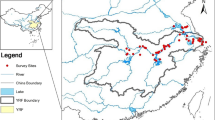Abstract
Taking Zhongba County, Angren County, Rikaze City located at the Upper and Middle Reaches of Yarlung Zangbo River as landscape units, this paper studied the difference of the landscape pattern under various degrees of human disturbance in the three areas. The results showed that: the three areas all reflected the same characteristic of landscape pattern in Qinghai-Tibet Plateau, the natural landscapes were in the absolute dominant position. However, from Zhangba to Rikaze, with human disturbance intensity increasing, anthropogenic features of landscapes became more and more outstanding. In Zhongba, the landscape structure appeared to be simpler with coarse grains and a less rich diversity. Conversely, in Rikaze, the landscape showed a complicated shape with finer grains and a relatively richer diversity. This reflected that the impact of human activities to natural landscape behaved a gradually-growing trend from the upper reach to the middle one of Yarlung Zangbo River Basin.
Similar content being viewed by others
References
Wu Jianguo.Landscape Ecology: Pattern, Process, Scale and Hierarchy [M]. Beijing: Higher Education Press, 2000:96–112 (Ch).
Naveh Z, Lieberman A S.Landscape Ecology Theory and application [M]. New York: Springer-Verlag, 1984:23–25.
Liu Shuhen, Fan Jianrong, Zhu Pingyi. Cause Analysis of Environmental Hazards in the Middle Reaches of Yarlung Zangbo River in Tibet [J].Journal of Natural Disasters, 2001,10(2):26–30 (Ch).
Jin Heling, Dong Guangrong, Liu Yuzhang,et al. The Sand Field Evolution and Climatic Changes in the Middle Course Area of Yarlung Zangbo River in Tibet, China Since 0.80 Ma B. P [J].Journal of Desert Research, 1998,18(2):97–104 (Ch).
Zhou Shunwu, Jia La, Du Jun. Analysis of Climatic Trend and Jump over Middle Reaches of Yarlung Zangbo River in Tibetan Plateau in Recent 42 Years [J].Plateau Meteorology, 2001,20(1):71–75 (Ch).
Li Shen, Dong Guangrong, Shen Jianyou,et al. The Formation Mechanism and Development Mode of Sand Geomorphology in Valleys of Yarlung Zangbo River [J].Science in China, Series D, 1999,29(1):88–96 (Ch).
Cai Xiaobu, Qian Chen, Huang Jie. Soil Erosion and Its Countermeasures in the Middle Reaches of Yarlung Zangbo River in Tibet Autonomous Region [J].Bulletin of Soil and Water Conservation, 1996,16(6):48–93 (Ch).
Jin Heling, Dong Guangrong, Li Shen. Study on the Cause, Developing Trend and Control Measures of Land Devertification in the Lower Middle Reaches of Yarlung Zangbo River [J].Journal of Desert, Research, 1997,17(3):48–93 (Ch).
Xu Jide, Lang Kuijian. Analyses on the landscape Ecotypes of Linzhi Prefecture in Tibet [J]Forest Resources Management, 2004, (5):53–57 (Ch).
He Xiaorong, Li Huixia. Discussion on Landscape Ecosystem Planning of Small Basin in the Qinghai-Tibet Plateau-Taking Nieruzangbu Basin as an Example [J].Wuhan University Journal of Natural Science, 2003,8(3B):940–948.
He Xiaorong, Zhong Xiangbao. Study on Classification of Landscape in Nieruzangbu Basin of Qinghai-Tibet Plateau [J].Journal of Mountain Science, 2005, (Suppl):64–70 (Ch).
Agricultural Bureau of Rikaze Prefecture, Tibet Autonomous Region.Land Resources of Rikaze Prefecture, Tibet Autonomous Region [M]. Beijing: China Agricultural Science & Technology Press, 1993: 6–13 (Ch)
O'Nelill R V. Indices of Landscape Pattern [J].Landscape Ecology, 1988, (1):153–162.
McGarigal K, Marks B J.FRAGSTATS: Spatial Pattern Analysis Program for Quantifying, Landscape Structure. Report No. PNW-GTR-351,USDA-Forest Service [R]. Portland: Pacific North-West Research Station, 1995.
Legendre P, Fortin M. Spatial Pattern And Ecological Analysis [J].Vegetation, 1989,80:107–138.
Turner M G, Gadner R H.Quantitative Methods in Landscape Ecology [M]. New York: Springer-Verlag, 1991.
Turner M G. Landscape Ecology: The Effect of Pattern on Process [J].Annual Review of Ecology Systematic, 1989,20:171–197.
Wines J A.The analysis of Landscape Patterns: Interdisciplinary Seminary Ecology [M]. Colorado: Colorado State University, 1988.
Author information
Authors and Affiliations
Corresponding author
Additional information
Foundation item: Supported by the National Basic Research Program of China (973 Program, G2003CB415201), the National Natural Science Foundation of China (30470297) and the Project by the Government of Rikaze Prefecture, Tibet Autonomous Region (C0403019)
Biography: XIONG Donghong(1974-), male, Ph. D. candidate, Assistant research professor, research direction: mountain environment and ecology.
Rights and permissions
About this article
Cite this article
Donghong, X., Zhong, Y., Xuehua, C. et al. Analysis on landscape pattern in the upper and middle reaches of Yarlung Zangbo River: Taking Zhongba County, Angren County, Rikaze City as example. Wuhan Univ. J. Nat. Sci. 11, 951–957 (2006). https://doi.org/10.1007/BF02830193
Received:
Issue Date:
DOI: https://doi.org/10.1007/BF02830193
Key words
- characteristics of landscape pattern
- impact of human activity
- the upper and middle reaches of Yarlung Zangbo River




